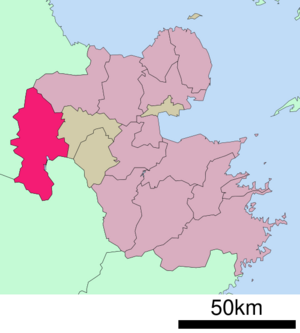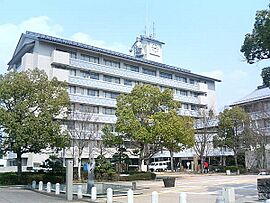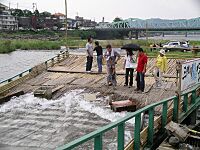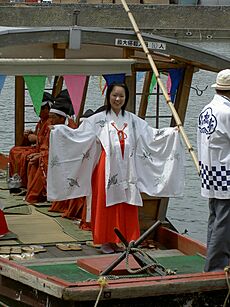Hita, Ōita facts for kids
Quick facts for kids
Hita
日田市
|
|||||||||||||
|---|---|---|---|---|---|---|---|---|---|---|---|---|---|
|
|||||||||||||
|
|||||||||||||
 |
|||||||||||||
| Country | Japan | ||||||||||||
| Region | Kyushu | ||||||||||||
| Prefecture | Ōita | ||||||||||||
| Area | |||||||||||||
| • Total | 666.03 km2 (257.16 sq mi) | ||||||||||||
| Population
(November 30, 2023)
|
|||||||||||||
| • Total | 61,148 | ||||||||||||
| • Density | 91.8097/km2 (237.786/sq mi) | ||||||||||||
| Time zone | UTC+09:00 (JST) | ||||||||||||
| City hall address | 2-6-1 Tashima, Hita-shi, Ōita-ken 877-8601 | ||||||||||||
| Climate | Cfa | ||||||||||||
|
|||||||||||||
Hita (日田市, Hita-shi) is a city in Ōita Prefecture, Japan. As of November 30, 2023, Hita had about 61,148 people living in 27,556 homes. The city covers an area of 666.03 square kilometers. This means there are about 96 people per square kilometer.
Contents
Exploring Hita's Geography
Hita is located in the far west of Ōita Prefecture. It shares borders with Fukuoka Prefecture and Kumamoto Prefecture. Nearby cities include Kurume to the west and Nakatsu to the north. Kusu is to the east.
Hita sits in a natural basin. This means it's like a bowl surrounded by mountains. Several rivers flow through Hita. These rivers eventually join to form the Chikugo River. Because of this river connection, Hita has a historical link to Fukuoka Prefecture. The local way of speaking, called the Hichiku dialect, is similar to dialects in Fukuoka, Nagasaki, and Saga Prefectures.
Many rivers in Hita flow into the Mikuma River. This river then becomes the Chikugo River. In the past, these rivers were used to transport lumber. This happened during the Edo Period. However, after the Yoake Dam was built, this route was no longer used.
The mountains around Hita are quite tall. Some reach 1,000 meters (3,281 feet) high. Mountains near Nakatsue, Maetsue, and Kamitsue are even taller. They can reach up to 1,200 meters (3,937 feet) above sea level.
Neighboring Cities and Towns
Hita is surrounded by several other municipalities. These are cities and towns in nearby prefectures.
- Fukuoka Prefecture
- Asakura
- Soeda
- Tōhō
- Ukiha
- Yame
- Kumamoto Prefecture
- Aso
- Kikuchi
- Minamioguni
- Oguni
- Yamaga
- Ōita Prefecture
- Kusu
- Nakatsu
Hita's Climate and Weather
Hita has a humid subtropical climate. This type of climate means it has hot, humid summers and mild winters. Because Hita is in a basin, temperatures can change a lot between day and night. This happens in both summer and winter.
Hita gets a lot of rain each year. More than a third of its rain falls during June and July. This is known as the East Asian rainy season. Heavy rainfall is common, and Hita has experienced severe floods in the past. From spring to autumn, a thick fog often appears in the mornings. Locals call this sokogiri, which means "shallow ground fog."
Summers in Hita are very hot. Temperatures often go above 35°C (95°F). Winters are quite cold. Sometimes, the temperature drops to -5°C (23°F). Hita gets more snow than most of Ōita Prefecture. In the main city, snow usually piles up to less than 10 cm (4 inches) a year. But in the mountain areas, it can snow more than 30 cm (12 inches).
The Maetsue mountain area gets a lot of rain. This helps grow Japanese cedar and Japanese cypress trees. These trees are important for the forestry industry. However, heavy rain can also cause landslides in these mountain areas.
| Climate data for Hita, Ōita (1991−2020 normals, extremes 1942−present) | |||||||||||||
|---|---|---|---|---|---|---|---|---|---|---|---|---|---|
| Month | Jan | Feb | Mar | Apr | May | Jun | Jul | Aug | Sep | Oct | Nov | Dec | Year |
| Record high °C (°F) | 21.5 (70.7) |
25.2 (77.4) |
27.7 (81.9) |
31.3 (88.3) |
36.3 (97.3) |
37.1 (98.8) |
39.3 (102.7) |
39.9 (103.8) |
38.0 (100.4) |
35.7 (96.3) |
27.9 (82.2) |
24.7 (76.5) |
39.9 (103.8) |
| Mean daily maximum °C (°F) | 9.8 (49.6) |
11.8 (53.2) |
15.7 (60.3) |
21.5 (70.7) |
26.4 (79.5) |
28.5 (83.3) |
32.3 (90.1) |
33.5 (92.3) |
29.5 (85.1) |
24.1 (75.4) |
18.1 (64.6) |
12.1 (53.8) |
21.9 (71.5) |
| Daily mean °C (°F) | 4.2 (39.6) |
5.6 (42.1) |
9.2 (48.6) |
14.5 (58.1) |
19.4 (66.9) |
23.0 (73.4) |
26.8 (80.2) |
27.4 (81.3) |
23.6 (74.5) |
17.6 (63.7) |
11.6 (52.9) |
6.1 (43.0) |
15.7 (60.4) |
| Mean daily minimum °C (°F) | −0.2 (31.6) |
0.5 (32.9) |
3.6 (38.5) |
8.2 (46.8) |
13.3 (55.9) |
18.6 (65.5) |
22.7 (72.9) |
23.1 (73.6) |
19.2 (66.6) |
12.5 (54.5) |
6.5 (43.7) |
1.5 (34.7) |
10.8 (51.4) |
| Record low °C (°F) | −10.8 (12.6) |
−9.9 (14.2) |
−7.8 (18.0) |
−4.4 (24.1) |
1.2 (34.2) |
7.1 (44.8) |
12.7 (54.9) |
14.1 (57.4) |
5.9 (42.6) |
−0.2 (31.6) |
−4.9 (23.2) |
−7.8 (18.0) |
−10.8 (12.6) |
| Average precipitation mm (inches) | 64.6 (2.54) |
81.4 (3.20) |
122.9 (4.84) |
128.1 (5.04) |
150.0 (5.91) |
352.1 (13.86) |
376.9 (14.84) |
189.1 (7.44) |
178.7 (7.04) |
87.4 (3.44) |
81.5 (3.21) |
63.6 (2.50) |
1,876.3 (73.87) |
| Average snowfall cm (inches) | 6 (2.4) |
4 (1.6) |
0 (0) |
0 (0) |
0 (0) |
0 (0) |
0 (0) |
0 (0) |
0 (0) |
0 (0) |
0 (0) |
1 (0.4) |
11 (4.3) |
| Average precipitation days (≥ 1.0 mm) | 8.7 | 9.1 | 10.5 | 9.7 | 8.7 | 13.2 | 12.6 | 10.7 | 9.3 | 6.9 | 7.8 | 8.2 | 115.4 |
| Average snowy days (≥ 1 cm) | 2.1 | 1.4 | 0.1 | 0 | 0 | 0 | 0 | 0 | 0 | 0 | 0.1 | 0.2 | 3.9 |
| Average relative humidity (%) | 76 | 72 | 70 | 67 | 67 | 74 | 76 | 74 | 76 | 75 | 78 | 78 | 74 |
| Mean monthly sunshine hours | 112.7 | 126.0 | 156.7 | 177.1 | 189.7 | 127.1 | 161.6 | 189.3 | 151.2 | 163.8 | 133.1 | 115.3 | 1,811 |
| Source: Japan Meteorological Agency | |||||||||||||
Hita's Population Over Time
Hita's population was 62,657 people in 2020. The city has been counting its residents since 1920.
| Historical population | ||||||||||||||||||||||||||||||||||||||||||||||||||||||||||||||||||||||
|---|---|---|---|---|---|---|---|---|---|---|---|---|---|---|---|---|---|---|---|---|---|---|---|---|---|---|---|---|---|---|---|---|---|---|---|---|---|---|---|---|---|---|---|---|---|---|---|---|---|---|---|---|---|---|---|---|---|---|---|---|---|---|---|---|---|---|---|---|---|---|
|
|
|||||||||||||||||||||||||||||||||||||||||||||||||||||||||||||||||||||
| Hita population statistics | ||||||||||||||||||||||||||||||||||||||||||||||||||||||||||||||||||||||
A Look Back: Hita's History
The area where Hita is today was once part of an ancient province called Bungo Province. Old writings from between 720 and 740 mention that Emperor Keiko visited this area. Many ancient burial mounds, called Kofun, show that a strong local kingdom existed here long ago.
During the Edo period (1603-1868), Hita was special. It was partly controlled by the Mori family and partly by the Tokugawa shogunate. The shogunate was the direct government of Japan at that time.
After the Meiji restoration in 1868, Japan changed a lot. On May 1, 1889, the towns of Mameda and Kuma were officially created. These towns later merged to form the town of Hita on November 1, 1901. Then, on December 11, 1940, Hita became a city. It merged with several nearby villages like Miyoshi and Mitsuoka. More villages joined Hita on March 31, 1955.
On March 22, 2005, Hita grew even bigger. It merged with the towns of Amagase and Ōyama. It also joined with the villages of Kamitsue, Maetsue, and Nakatsue. After this merger, the city of Hita covered the same area as the original Hita District, which was then officially ended.
Hita's Economy and Industries
Forestry has always been important in Hita. The mountains around the city have lots of trees. These trees are used to make "Hita Cedar" products. These include traditional Japanese wooden sandals called geta and beautiful lacquerware. However, in recent years, the forestry industry has faced challenges. This is because cheaper wood is imported from other countries.
Since the 1960s, farming in Hita has changed. It became harder to find large areas of flat land for growing rice. So, farmers started growing crops in the mountains. These include ume (Japanese plums), Japanese chestnuts, and mushrooms.
There is also a fishing industry in Hita. Fishermen catch ayu and other fish in the Mikuma River.
Hita is also known for its excellent water quality. A company called Hita Tenryosui produces mineral water. Many distilleries in Hita make sake (rice wine) and shōchū (a Japanese distilled spirit).
In recent times, big companies have set up factories in Hita. These include TDK, Kyushu Sumidenso, Sapporo Breweries, and Sanwa Shurui.
Traditional Crafts of Hita
Hita is famous for its unique traditional crafts:
- Wooden geta: These traditional Japanese sandals are made from the cedar trees found around Hita.
- Onta ware: This is a special type of pottery. It is made in the mountain village of Onta.
Education in Hita
Hita has many schools for young people. The city government runs 18 public elementary schools and 12 public junior high schools. The Ōita Prefectural Board of Education operates three public high schools. There are also two private high schools in Hita.
Getting Around: Hita's Transportation
Railways
![]() JR Kyushu operates two train lines in Hita:
JR Kyushu operates two train lines in Hita:
- Kyūdai Main Line
- Yoake - Teruoka - Hita - Bungo-Miyoshi - Bungo-Nakagawa - Amagase
- Hitahikosan Line
- Yoake - Imayama - Ōtsuru (Note: Due to heavy rain damage in July 2017, trains on this line have been replaced by a Bus rapid transit service.)
Highways
Hita is connected by several important roads:
 Ōita Expressway
Ōita Expressway National Route 210
National Route 210 National Route 211
National Route 211 National Route 212
National Route 212 National Route 386
National Route 386 National Route 387
National Route 387 National Route 442
National Route 442 National Route 496
National Route 496
Fun Things to See and Do in Hita
Popular Tourist Spots
During the Edo period, Hita was designed to be like Kyoto. Because of this, it is sometimes called "Little Kyoto." You can still see traces of old Kyoto in the streets of Mameda-machi. This town has many old buildings that have been kept in good condition. Some important buildings include:
- The Hirose Museum (廣瀬資料館)
- The Kusano House (草野本家)
- The Nihongan Medicine Museum (日本丸館)
- The Tenryō Hita Museum (天領日田資料館)
There is also the Kuncho Shuzō Sake Brewery (薫長酒蔵資料館). It has a museum where you can learn about sake making and a shop.
Kangien (咸宜園跡) was a private school started by Hirose Tansō in 1805. The school's name means "everyone is welcome." Students from all over Japan came to study here. It didn't matter how old they were, if they were male or female, or what their social class was. Kangien is now a Japan Heritage site. Two original buildings, Shūfūan and Enshirō, are still standing. There is also an education research center at the site.
The Taio gold mine is in Nakatsue village. This mine operated from 1898 to 1972. Today, it is a museum where you can learn about its history.
From July to November, you can see fishermen setting up bamboo fish traps in the Mikuma River. They use these traps to catch ayu fish. These fish are often covered in salt and grilled.
Hita is also home to many onsen (hot springs). You can find them especially along the Mikuma River and in Amagase.
The former village of Kamitsue has an international racing track called Autopolis.
The luxurious Aru Ressha train travels between Ōita and Hita. It was designed by Eiji Mitooka. This train helps bring more tourists and boost the local economy.
Exciting Festivals in Hita
Hita hosts many festivals throughout the year. These events attract many visitors.
- Tenryō Hita Ohina Festival
This girl's doll festival (天領日田おひなまつり) happens every year. It runs from February 15 to March 31, around the time of the national Hinamatsuri. During this festival, museums and old houses in Mameda-machi and Kuma-machi open their doors. They display their collections of beautiful dolls.
- Hita Kawabiraki Kankōsai River Opening Festival
This festival (日田川開き観光祭) is held on the first weekend after May 20. It celebrates the start of the ayu fishing season on the Mikuma River. More than 10,000 fireworks light up the sky over the river. This amazing display lasts for two days.
- Hita Gion Festival
The Hita Gion Festival (日田祇園祭) takes place on the first weekend after July 20. It is inspired by the famous Gion Festival in Kyoto. Huge wooden yamaboko floats, some up to 12 meters (39 feet) tall, are pulled through the streets. Volunteers from different parts of the city help move these impressive floats. You can also see these floats at the Gion Yamaboko Hall (日田祇園山鉾会館) in Kuma-machi all year round.
- Sen-nen Akari Bamboo Light Festival
Sen-nen Akari (千年あかり) is held from Friday to Sunday during the third week of November. For three nights, bamboo lights glow along the streets of Mameda-machi and the nearby Kagestu River. This beautiful festival started in 2005.
- Hita Tenryō Festival
The Hita Tenryō Festival (日田天領まつり) is celebrated on the third weekend in November. This festival remembers Hita's history during the Edo period. At that time, Hita was directly controlled by the Tokugawa government. The main event is a parade of 200 people dressed in full Edo-period costumes. The festival's name, tenryō, refers to lands directly managed by the Tokugawa shogunate.
Delicious Local Foods in Hita
Hita has many special local foods.
- One of the most famous is Hita Yakisoba. This noodle dish is cooked in a special way that makes it crispier than regular yakisoba.
- Takanazushi is a type of sushi. It is made with takana (a type of leaf mustard) and nori (seaweed).
- The seasoning yuzukoshō is believed to have been first made in Hita.
Famous People from Hita
Hita is the hometown of several notable individuals:
- Hajime Isayama (manga artist and writer, known for Attack on Titan)
- Keisuke Kimoto (Football player)
- Koji Kuramoto (judo athlete)
- Sayami Matsushita (archer)
- Junko Maya (actress)
- Kaoru Mitoma (Football player)
- Hirose Tansō (scholar and writer, who founded Kangien school)
See also
 In Spanish: Hita (Ōita) para niños
In Spanish: Hita (Ōita) para niños

















